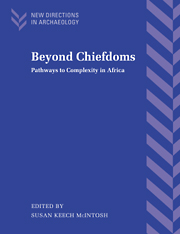Book contents
- Frontmatter
- Contents
- List of figures
- List of tables
- List of contributors
- Preface
- 1 Pathways to complexity: an African perspective
- 2 The segmentary state and the ritual phase in political economy
- 3 Perceiving variability in time and space: the evolutionary mapping of African societies
- 4 Western representations of urbanism and invisible African towns
- 5 Modeling political organization in large-scale settlement clusters: a case study from the Inland Niger Delta
- 6 Sacred centers and urbanization in West Central Africa
- 7 Permutations in patrimonialism and populism: The Aghem chiefdoms of Western Cameroon
- 8 Wonderful society: the Burgess Shale creatures, Mandara polities, and the nature of prehistory
- 9 Material culture and the dialectics of identity in the Kalahari: AD 700–1700
- 10 Seeking and keeping power in Bunyoro-Kitara, Uganda
- 11 The (in)visible roots of Bunyoro-Kitara and Buganda in the Lakes region: AD 800–1300
- 12 The power of symbols and the symbols of power through time: probing the Luba past
- 13 Pathways of political development in equatorial Africa and neo-evolutionary theory
- Index
2 - The segmentary state and the ritual phase in political economy
Published online by Cambridge University Press: 14 October 2009
- Frontmatter
- Contents
- List of figures
- List of tables
- List of contributors
- Preface
- 1 Pathways to complexity: an African perspective
- 2 The segmentary state and the ritual phase in political economy
- 3 Perceiving variability in time and space: the evolutionary mapping of African societies
- 4 Western representations of urbanism and invisible African towns
- 5 Modeling political organization in large-scale settlement clusters: a case study from the Inland Niger Delta
- 6 Sacred centers and urbanization in West Central Africa
- 7 Permutations in patrimonialism and populism: The Aghem chiefdoms of Western Cameroon
- 8 Wonderful society: the Burgess Shale creatures, Mandara polities, and the nature of prehistory
- 9 Material culture and the dialectics of identity in the Kalahari: AD 700–1700
- 10 Seeking and keeping power in Bunyoro-Kitara, Uganda
- 11 The (in)visible roots of Bunyoro-Kitara and Buganda in the Lakes region: AD 800–1300
- 12 The power of symbols and the symbols of power through time: probing the Luba past
- 13 Pathways of political development in equatorial Africa and neo-evolutionary theory
- Index
Summary
The ethnography of the Alur segmentary state
The Alur taught me the practice of the segmentary state, as well as their language. I had to make it theory in my language, the most stereotypical and intractable form of distancing the Other. The segmentary state is one in which the spheres of ritual suzerainty and political sovereignty do not coincide. The former extends widely towards a flexible, changing periphery. The latter is confined to the central, core domain. A number of such partially overlapping entities with political cores at the center of wider ritually based zones may be related to one another pyramidally at several levels. The Other may be partially assuaged by exploring the origin of the Alur segmentary state. Alur society emerged as a distinct entity in the sixteenth and seventeenth centuries, when Lwo migrants from the north crossed the Nile and moved west (Crazzolara 1950/51). The segmentary state of Atyak became the largest among the Alur (Southall 1956: 349), because its early leaders and their following moved into a part of the country where they were able to develop the most favorable combination of agriculture and pastoralism, while also remaining beyond the disturbing influence of Bunyoro (Southall 1956: 9, 16). As they moved up into the highlands, they were able to incorporate (Southall 1970) small groups of earlier settlers (Okebo, Lendu, Madi, Abira, etc.) who belonged to quite different ethnic groups and spoke mutually unintelligible languages (Southall 1956: 16–24). I have not found it possible to relate the concept of the internal frontier to this situation in any meaningful way.
My account represents the most plausible hypothesis based on Alur traditions and elders' statements.
- Type
- Chapter
- Information
- Beyond ChiefdomsPathways to Complexity in Africa, pp. 31 - 38Publisher: Cambridge University PressPrint publication year: 1999
- 10
- Cited by



